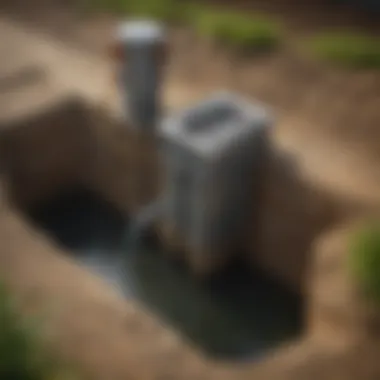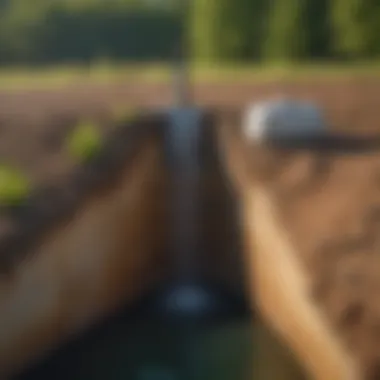Understanding Sump Pump Reservoirs: Key Insights for Farmers


Intro
Sump pump reservoirs play a crucial role in managing excess water, particularly in agricultural settings. They serve as essential units designed to collect and redirect water effectively. In understanding how these reservoirs function, their design principles, and maintenance requirements, one can appreciate their impact on water management.
These systems are particularly vital in regions prone to heavy rainfall or flooding, where crops must be protected from water accumulation. The effective use of sump pump reservoirs can significantly enhance farming practices, ensuring both soil health and crop yield are maintained. As we delve deeper into this topic, we will explore relevant trends and techniques that empower farmers to optimize their water management strategies.
Current Trends in Agriculture and Horticulture
Overview of Recent Innovations
Recent innovations in agricultural practices have spotlighted the importance of efficient water management. With climate change contributing to unpredictable weather patterns, the demand for reliable drainage systems like sump pump reservoirs has grown. Many farmers are adopting smart technologies integrated into their water management systems, which allow for real-time monitoring of water levels.
Sustainable Practices Gaining Popularity
Sustainability has become a focal point in modern agriculture. Farmers are now more conscious of their water usage and the impact of excessive drainage on local ecosystems. Sump pump reservoirs are being designed with sustainability in mind. They often incorporate features like rainwater harvesting, which ensures that water is reused rather than wasted. This focus on sustainability leads to better soil health and minimizes the negative effects of water management practices.
Essential Farming Techniques
Soil Health Management
Soil health is paramount in agriculture, directly influencing crop productivity. Proper drainage is vital in preventing soil erosion and nutrient leaching, which can occur due to poor water management. Implementing sump pump reservoirs allows for controlled water drainage, helping to maintain optimal moisture levels in the soil.
Pest and Disease Control Strategies
Water accumulation can create a breeding ground for pests and diseases. By employing sump pump reservoirs, farmers can mitigate risks associated with waterlogged conditions. This proactive approach avoids the need for chemical interventions, promoting natural pest control methods that benefit the ecosystem.
Tools and Technology in Farming
Overview of Advanced Farming Tools
Today's farmers have access to a broad array of advanced tools that enhance agricultural efficiency. These include precision irrigation systems that complement sump pump reservoirs, allowing for precise water usage tailored to crop needs.
Case Studies on the Use of Technology
Several case studies illustrate the effectiveness of combining technology and sump pump reservoirs. For instance, farms that implemented sensor-based systems reported significant reductions in water waste and increased crop yields. These technologies not only optimize water management but also contribute to cultivating a healthier environment.
"Efficient water management techniques are crucial for modern agriculture, helping to secure food production in changing climatic conditions."
Overall, understanding the function, design, and maintenance of sump pump reservoirs is essential for farmers seeking to enhance their agricultural practices. By embracing current trends, essential techniques, and modern tools, one can effectively address water management challenges while promoting sustainability.
Prologue to Sump Pump Reservoirs
Sump pump reservoirs are critical components in water management systems, particularly in agricultural settings. Understanding their role can help farmers and enthusiasts optimize drainage, addressing water accumulation that may adversely affect crop yields. This section will shed light on the definition and significance of sump pump reservoirs, providing a solid foundation for the remainder of this article.
Defining Sump Pump Reservoirs
Sump pump reservoirs serve as storage facilities for excess water that has been pumped away from fields or basements. Typically made from strong materials such as plastic, polyethylene, or fiberglass, these reservoirs are located below ground, allowing gravity to assist with water collection. The size and capacity of these reservoirs can vary widely, depending on the specific requirements of the site and the amount of water needing to be managed.
In simple terms, a sump pump reservoir acts as a catch basin, collecting unwanted water so it can be effectively discharged away from sensitive areas. When rainfall is abundant or when irrigation systems operate, these reservoirs come into play. They not only help manage water flow but also protect soil from saturation, ultimately contributing to better farming conditions.
Importance in Water Management
The importance of sump pump reservoirs in water management cannot be overstated. They serve multiple purposes that directly benefit agricultural practices. Here are some key aspects:
- Flood Prevention: By collecting excess rainwater, reservoirs mitigate the risk of flooding, which can damage crops and farmland.
- Soil Health: Proper water management supports optimal soil moisture levels. This helps maintain soil structure and nutrient availability.
- Irrigation Efficiency: Sump pump reservoirs can help in efficient irrigation by controlling runoff water. Allows farmers to reuse water rather than relying solely on external sources.
- Erosion Control: By managing water flow, these reservoirs can help prevent soil erosion, preserving valuable topsoil essential for crop growth.
"Proper management of water resources is key to sustainable agriculture. Sump pump reservoirs play an essential role in this management."


In summary, understanding sump pump reservoirs and their significance lays the groundwork for constructing efficient water management systems. It is critical for farmers, students, and enthusiasts to recognize these systems as tools that not only protect crops but also improve overall land use and management strategies.
Components of a Sump Pump Reservoir
Sump pump reservoirs play a pivotal role in managing water effectively. Understanding their components is vital for anyone involved in agricultural water management. This section delves into the essential elements that constitute these reservoirs, highlighting the benefits of appropriately chosen materials and optimal sizing to ensure functionality and longevity.
Material Considerations
The materials selected for a sump pump reservoir significantly influence its performance and durability. Proficiently designed reservoirs are usually built from materials like concrete, fiberglass, or high-density polyethylene. Each of these materials has its own set of advantages and disadvantages.
- Concrete is robust and offers good insulating properties. However, it can be prone to cracking if not properly cured.
- Fiberglass is lightweight, resistant to corrosion and decay, making it an excellent choice for humid conditions.
- High-density polyethylene is known for its flexibility and resistance to impact but may not support heavy loads as well as concrete.
Selecting the right material ensures that the reservoir can withstand environmental stressors, such as soil movement and water pressure. Moreover, choosing materials that comply with local agricultural regulations adds another layer of reliability.
Sizing and Capacity Factors
Determining the appropriate size and capacity of a sump pump reservoir is crucial for effective water management. Several factors need to be taken into account during this process. Firstly, the expected volume of water accumulation must be evaluated. This involves analyzing rainfall patterns, drainage areas, and soil saturation levels.
A reservoir that is too small can lead to overflow and system failure, while an oversized reservoir may result in unnecessary costs and space usage. Often, calculations based on historical weather data provide valuable insights into sizing needs.
- Volume estimates can be calculated using:
- Area of drainage multiplied by the depth of water to be managed.
- Seasonal variations in rainfall and snowmelt, which can impact usability.
Additionally, considering future land-use changes is wise. This foresight can prevent inefficient use of resources. Designing for flexibility in capacity can save headaches later on.
"Choosing suitable materials and sizing is just as critical as the sump pump itself. A small miscalculation can lead to bigger problems down the line."
In summary, understanding both material selection and sizing aspects is fundamental in optimizing sump pump reservoirs for agricultural applications. These components must not be overlooked; they directly contribute to the functionality and efficiency of the drainage system. By focusing on these areas, farmers can effectively manage water accumulation and enhance their agricultural productivity.
How Sump Pump Reservoirs Function
Understanding how sump pump reservoirs function is crucial for effective water management in agricultural settings. These systems are designed to collect water and manage its removal efficiently, preventing water accumulation that can harm crops and compromise soil health. This section delves into the mechanics of water collection and highlights the critical role of the sump pump within the reservoir system.
Mechanics of Water Collection
Water collection in sump pump reservoirs involves various elements working together to ensure efficient drainage. The primary function of a reservoir is to gather excess water from surrounding areas, such as rainwater or runoff. The design usually includes a basin with sufficient capacity to handle significant water flow. This basin is typically placed below ground level, enhancing gravity-assisted drainage.
The mechanics involve a few key components:
- Inlet Pipes: These pipes direct water toward the reservoir. They are strategically located to capture runoff from roofs, fields, or other permeable surfaces.
- Basins: The basin serves as the main collection area. Its depth and width depend on the expected water volume and the surrounding drainage patterns.
- Drainage Systems: Effective drainage systems prevent overflow by ensuring that the collected water is removed in a timely manner. This is crucial during heavy rainfall or sudden snowmelt.
Regular checks on the inlet pipes and basin for clogs or blockages are necessary. Even small debris can hinder functionality, leading to water backflow and potential flooding.
Role of the Sump Pump
The sump pump is a vital part of the overall water management system. Once water enters the reservoir, the sump pump takes on the task of removing it. This device is typically installed at the lowest point of the reservoir. As water levels rise, the pump activates to push the water out through outlet pipes to a designated drainage area.
There are several important considerations regarding sump pumps:
- Type of Sump Pump: Some common types include submersible pumps and pedestal pumps. Each type has its advantages and specific scenarios where it may be more efficient.
- Power Source: Ensuring an adequate power source for the sump pump is essential. In some agricultural settings, backup power options, such as batteries or generators, can be beneficial during power outages.
- Maintenance Needs: Regular maintenance of the sump pump is crucial for optimal performance. This includes cleaning out debris, checking the float switch, and ensuring proper electrical connections.
"A well-functioning sump pump can be the difference between productive land and waterlogged fields that struggle to yield crops."
Design Considerations for Effective Systems
The design of sump pump reservoirs plays a crucial role in ensuring optimal water management. It encompasses various elements such as placement, size, and integration with existing systems. Effective design can prevent water accumulation, reduce the risks of flooding, and enhance the efficiency of drainage systems. To achieve this, careful consideration must be given to site assessment and the incorporation of drainage solutions.


Site Assessment and Planning
Site assessment is an essential first step in the design process. It involves evaluating the characteristics of the land, including soil texture, drainage patterns, and proximity to water sources. Knowing the local environment can significantly affect the performance of a sump pump reservoir. For instance, clay soils retain water longer, which may necessitate a larger reservoir. Additionally, local regulations and environmental factors should also influence the site selection.
Proper planning entails considering potential water sources, such as runoff from fields, or rainfall. This affects the reservoir's size and capacity. Without thorough site planning, the system may become ineffective, leading to higher costs over time and unnecessary maintenance.
Incorporating Drainage Solutions
Integrating drainage solutions into the sump pump system enhances its overall functionality. Various methods can be employed to effectively manage water flow. These include:
- Grading - Adjusting the landscape to direct water flow toward the reservoir. This decreases the chance of run-off pooling in undesired areas.
- French Drains - Installing perforated pipes in trenches filled with gravel can help in redirecting water away from buildings and toward the sump pump reservoir.
- Catch Basins - These structures collect surface water and allow it to flow into the reservoir, improving efficiency in water management.
Adopting these solutions ensures that the reservoir functions effectively and minimizes the need for excessive intervention by the sump pump. It creates a more harmonious working environment for the reservoir in the broader water management system.
"An adequately designed sump pump reservoir prevents issues that stem from poor site management, ensuring long-term efficiency and performance."
In summary, effective design considerations for sump pump reservoirs involve careful planning based on site assessment and the integration of appropriate drainage solutions. Each aspect plays a pivotal role in the overall success of water management strategies in agricultural contexts.
Installation Procedures
Proper installation of sump pump reservoirs is crucial for their effective operation and longevity. The procedures involved in setting up these systems can significantly impact their performance and reliability. Understanding the installation process not only aids in achieving optimal function but also ensures compliance with relevant regulations. An organized installation reduces the potential for future issues, thereby decreasing maintenance costs and operational downtime.
Step-by-Step Installation
The installation of a sump pump reservoir involves several key steps, each warranting careful attention to detail. Here’s a straightforward guide:
- Site Assessment: Before anything else, conduct a thorough evaluation of the area where the sump pump will be installed. Consider the elevation, soil type, and proximity to water sources.
- Excavation: Dig a hole that is appropriate for the size of your reservoir. It must be deep enough to accommodate the pump while allowing for proper drainage.
- Foundation Preparation: Ensure the bottom of the excavated area is level. A stable, flat base will help prevent future shifting of the reservoir.
- Setup of the Reservoir: Place the sump pump reservoir into the hole. Check for stability and make certain that it is level. This is vital for effective water drainage.
- Connect the Pump: Install the sump pump in the basin of the reservoir according to the manufacturer’s instructions. Ensure all fittings are secure to prevent leaks.
- Backfill: After confirming that everything is in position, begin to backfill the area around the reservoir being careful not to compress it too tightly.
- Testing: Once installation is complete, run the pump to check for functionality. Monitor for any unusual noises or malfunctions.
- Final Check: Inspect for leaks or uneven settling. Make immediate adjustments as necessary.
These steps create a strategic foundation for ongoing efficiencies in water management. Without attention to detail in the installation process, users risk encountering significant operational issues.
Legal and Regulatory Considerations
When installing sump pump reservoirs, it is 重要 to familiarize yourself with local zoning laws and building codes. Non-compliance can lead to penalties or forced removal of the system. Key considerations to keep in mind include:
- Permits: Depending on your location, a permit may be required before starting the installation. Check with your local government to ensure all necessary permissions are obtained.
- Environmental Regulations: Some regions have specific requirements to protect surrounding ecosystems. This might include regulations about drainage or water discharge methods.
- Safety Standards: Follow all guidelines related to electrical work, especially if your sump pump operates on an electrical system. This can prevent both accidents and legal issues.
- Municipal Guidelines: Consult your city or county's public works department for any specific rules that pertain directly to sump pump installations.
A well-planned installation, compliant with legal standards, saves considerable time and resources in the long run.
Adhering to these guidelines is essential not only to optimize performance but also to foster trust and safety within the community.
Maintenance of Sump Pump Reservoirs
Maintenance of sump pump reservoirs is crucial for ensuring efficient water management. Neglecting this aspect can lead to severe consequences, such as flooding or equipment failure. Regular upkeep not only extends the lifespan of the system but also enhances its performance. Understanding the essential tasks involved in this maintenance regime allows users to prevent costly repairs and safeguard their properties from water damage.
Routine Maintenance Tasks
Routine maintenance tasks are fundamental in keeping sump pump reservoirs functioning optimally. These tasks include:
- Regular Inspections: Checking the sump pump at least once a month is vital. Look for wear signs, debris presence, or strange noises.
- Cleaning the Reservoir: Clear out any sediment or debris that accumulates in the reservoir. This keeps the pump from getting clogged and ensures smooth operation.
- Testing the Pump: Activate the pump to ensure it functions correctly. This should be done several times a year to catch any potential failures early.
- Check the Power Supply: Regularly inspect the power source to ensure there is no disruption. A backup power source is also a wise investment.
- Examine the Discharge Pipe: Ensure that the pipe directing water away from the reservoir is free of blockages. This step prevents backflow and maintains proper drainage.
By adhering to these practices, users can significantly reduce the risk of unexpected failures.
Troubleshooting Common Issues
Despite careful maintenance, there may be instances where issues arise in sump pump reservoirs. Understanding how to troubleshoot these common problems is essential for effective resolution:
- Pump Not Turning On: This could be due to a faulty power source. Check the electrical connections and ensure there is power to the unit. Sometimes, a simple reset can solve the problem.
- Pump Running Continuously: If the unit runs non-stop, it may indicate a faulty float switch or an improperly set float level. Adjusting or replacing the float can often remedy the issue.
- Strange Noises: Unusual sounds can signal a mechanical problem. Inspect the impeller and motor for issues. If necessary, consult a professional for repairs.
- Water Levels Too High: If water accumulates beyond normal levels, the pump might be undersized. Alternatively, blockages in the discharge pipe may prevent proper drainage.


"Proactive maintenance and effective troubleshooting can prevent severe issues and ensure your sump pump reservoir operates efficiently."
By staying vigilant about these problems and their solutions, users can maintain a resilient and effective water management system.
Challenges in Managing Sump Pump Reservoirs
Managing sump pump reservoirs presents several challenges that require attention and understanding. These issues range from mechanical failures to environmental factors that can impact the efficiency of these systems. Recognizing these challenges is essential for maintaining effective water management practices.
Potential Failures and Risks
One key challenge in managing sump pump reservoirs is the potential for mechanical failures. A sump pump can fail due to several reasons, including power outages, insufficient maintenance, or clogging caused by debris. If the pump fails, the reservoir can overflow, leading to significant water damage in nearby areas. This is particularly critical in agricultural settings, where crops may be at risk from flooding. Furthermore, if a pump runs continuously without adequate water levels in the reservoir, it can overheat and fail.
Regular maintenance is crucial to mitigate these risks. Performing routine checks such as testing the pump's function, cleaning the sump pit, and ensuring that float switches are operational can enhance reliability. Additionally, installing backup systems like a secondary pump or a battery backup can provide an extra layer of security against failures.
Environmental Considerations
Environmental factors also pose challenges. Sump pump reservoirs are often used for managing agricultural runoff and stormwater. Inadequate design and planning can lead to issues with local ecosystems. For instance, improper disposal of collected water can introduce pollutants into natural waterways.
Furthermore, sump pump reservoirs are essential during heavy rains; however, if not designed correctly, they can cause erosion or sediment buildup. This can negatively impact the soil and surrounding flora. Careful attention to soil type, vegetation, and drainage patterns is necessary during the design phase.
Stakeholders need to assess the environmental impact continually. Implementing practices like regular evaluations of water quality and ecosystem health enhances the sustainability of the water management system. Additionally, integrating solutions such as green infrastructure can help reduce the ecological footprint of sump pump reservoirs.
"Proactive management of potential failures and environmental risks is necessary to ensure that sump pump reservoirs serve their purpose effectively."
Best Practices for Efficient Use
Implementing best practices in sump pump reservoir management is key to ensuring they operate effectively. Efficiency can greatly impact water management in agricultural operations. By observing proven strategies, users can not only optimize performance but also reduce maintenance costs and environmental impact.
Integrating with Existing Systems
Integration of sump pump reservoirs with existing drainage systems is crucial. It requires careful planning and assessment of current infrastructure. Proper alignment enhances system efficiency and functionality.
- Mapping the System: Before integration, conduct a detailed assessment of the current drainage layout. Identify the flow of water and potential trouble spots that a sump pump can address. Utilize tools like GIS (Geographic Information System) for precise mapping.
- Compatibility Checks: Ensure the selected sump pump system is compatible with existing pumps and drainage lines. Mismatched systems can lead to inefficiencies or failures. It’s essential to align the capacities and specifications of installed pumps with the new sump pump landscape.
- Utilizing Maintenance Protocols: Incorporate maintenance schedules for all systems to prevent obsolescence and maintain productivity. Issues in one part of the system could jeopardize the effectiveness of the entire setup.
Integrating these practices helps prevent water accumulation and maximizes agricultural output.
Monitoring and Adaptation
Regular monitoring of the sump pump reservoir and its surrounding environment is vital. Observing performance metrics allows for timely interventions.
- Performance Analysis: Consistent assessment of flow rates and water levels is necessary. Use smart sensors to track performance metrics and receive alerts for irregularities.
- Adapting to Environmental Changes: Climate variability and changes in land use can alter water drainage needs. Adapt the reservoir’s design and capacity based on these changes. For example, increased rainfall patterns may require expanded capacity or more frequent maintenance schedules.
- Community Engagement: Encourage discussions and share findings with local agricultural communities or forums, such as those on Reddit. Sharing insights can provide valuable peer feedback and innovative solutions.
Incorporating these monitoring practices can lead to prolonged pump life, decreased energy consumption, and optimized water management.
"A well-maintained sump pump reservoir is critical to effective water management and agricultural success. Adaptation ensures that systems continue to serve their purpose effectively over time."
By strategically integrating these systems and remaining vigilant through ongoing monitoring, farmers can achieve a state of efficiency that not only optimizes their operations but also contributes to broader environmental goals. Effective use of sump pump reservoirs guides farmers toward a sustainable agricultural practice.
Finale
In the context of this article, concluding on sump pump reservoirs is vital as it synthesizes the multitude of elements covered. Sump pump reservoirs act as a cornerstone in effective water management, ensuring that water is collected and diverted efficiently, especially in agricultural settings. Their role extends beyond mere function; understanding their design, installation, and maintenance has significant implications for efficiency and sustainability.
The Future of Sump Pump Reservoirs
The future landscape of sump pump reservoirs will likely be shaped by advancements in technology and increased awareness of environmental considerations. Innovations in materials used for construction could lead to longer-lasting reservoirs that are easier to maintain. Integration with smart technology can also play a role, allowing for real-time monitoring of water levels and enable predictive maintenance.
As global weather patterns become more erratic, reliance on efficient drainage solutions will grow. This underscores the importance of conducting proper site assessments, selecting suitable materials, and adapting existing systems to meet new challenges.
"Effective drainage and water management is not just crucial for crops; it is essential for the environment we depend on."
Farmers and enthusiasts should prioritize continuous learning and adaptation within this sphere. Community engagement, such as participating in forums on platforms like Reddit or groups on Facebook, can also provide valuable insights from peers facing similar challenges. This connection can foster innovative ideas on managing sump pump reservoirs.
To summarize, understanding and improving upon sump pump reservoirs today not only addresses current agricultural needs but also prepares us for a sustainable future where water management becomes increasingly critical.



